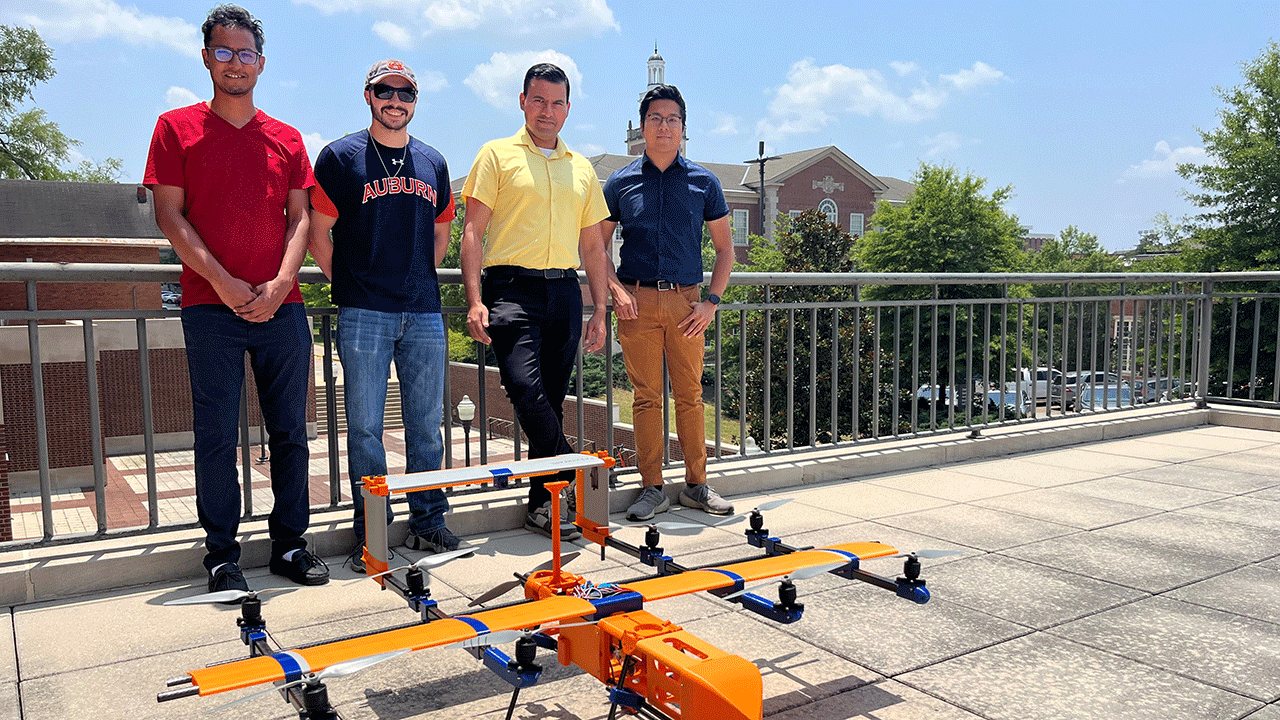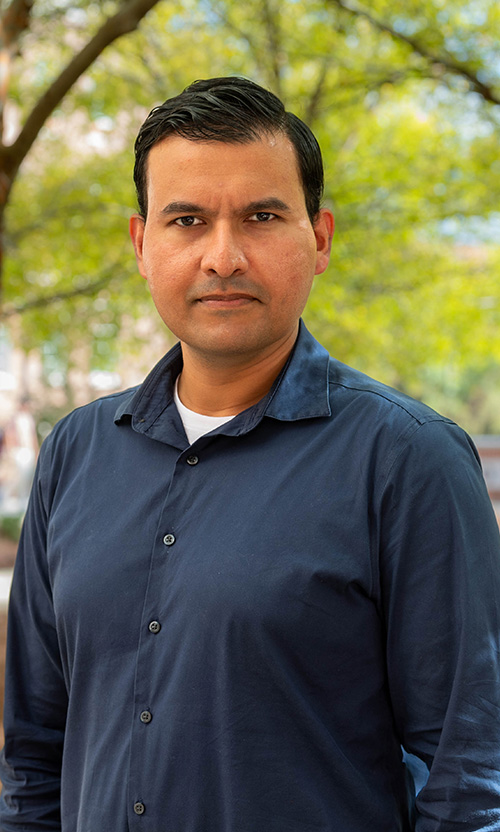Vehicle Systems, Dynamics, and Design Laboratory team wins Vertical Flight Society international competition
Published: Jul 7, 2023 9:15 AM
By Joe McAdory
Three aerospace engineering graduate students in Imon Chakraborty’s Vehicle Systems, Dynamics, and Design Laboratory (VSDDL) took first place in the Vertical Flight Society’s Design-Build-Vertical Flight (DBVF) 2023 Student Competition final round June 6-8 in Churchville, Maryland.
The event was hosted by SURVICE Engineering’s Applied Technology Operation at the Harford County (Maryland) Airport. The University of Maryland took second place, while McGill University from Quebec, Canada, was third.
Anthony Comer, Rajan Bhandari and Stefanus Harris Putra designed, built and flew a vertical takeoff and landing (VTOL) aircraft manually and autonomously – and were the only team to complete both mission tasks. Teams were challenged to build VTOL aircraft weighing no more than 20 pounds and capable of carrying payloads of at least two pounds, with sufficient endurance to complete the competition requirements.
Auburn’s subscale version of a lift-plus-cruise aircraft (named LPC-03-s Phoenix Lite) was capable of taking off like a helicopter, then transitioning to forward flight like an airplane. The LPC-03-s, soon to be on display in Davis Hall, has eight lift propulsors, used for vertical and transition modes of flight, and one cruise propulsor, used for transition and forward flight modes. The vehicle was made of carbon fiber tubes and rods for the main structure and 3D-printed parts for the external parts.
How did Auburn win? The team’s aircraft was repairable and able to fly again after mishaps. Other entries, for the most part, were not.
“It was put together like a Lego set, piece-by-piece,” said Comer, the team’s captain. “This design helped us to come back from two crashes we had during the competition -- rebuilding the vehicle twice and returning to the flight area within a few hours of each crash.”
While the 3D-printed parts are more prone to cracking and shattering during crashes when compared to conventional materials such as balsa or foam, they end up absorbing most of the crash energy in crashes, protecting the difficult-to- machine and expensive carbon fiber rods as well as the onboard electronics.
“We also printed the parts in smaller segments, which makes it possible to slide out broken pieces and replace them easily and fast,” Putra said. “3D printing also enables us to essentially keep prints going while we do flight tests, which enables us to always have enough extra parts for an entirely new vehicle.”

Team VSDDL wasn’t impervious to crashes, but they bounced back twice after crashing twice, including on the second day of competition when the cruise propeller detached from the vehicle mid-flight during the manual flight attempt of the competition. A second crash occurred in the final moments of an almost-successful autonomous flight due to a previously undetected error in the autonomous navigation logic that the team was using.
“We were able to repair it overnight and got it ready for the final day, where we managed to fly it autonomously with the updated navigation system that we developed in the hotel room using our simulation model of the vehicle,” Putra said.
Chakraborty, assistant professor in aerospace engineering, said the event “proves that we have talented students in our program who are enthusiastic about projects where they have to make and build in real-life, in addition to modeling and analyzing on a computer.”
“It shows that our students can take concepts and theories that they have studied in the classroom or through their research and apply them to a real-life engineering problem,” he said.
Roles on the team varied. Comer served as captain and was responsible for timeline planning and development/testing of a simulation model of the sub-scale vehicle and interfacing this with the vehicle hardware. He also flew the vehicle during flight tests and the competition.
Bhandari is considered as the “main builder” of the vehicle, doing much of the electronic soldering and electrical wiring. He also worked to improve the sizing process to provide accurate estimates of the vehicle weight and physical characteristics before it was built.
Putra, who aspires for a career in aircraft subsystems or electric aircraft, was the main computer-aided design specialist, making updates to the model when required. He also kept inventory on parts and oversaw the 3D-printing of required parts and helped Bhandari build the vehicle as well as making checklists.
“These competitions play an important role in implementing the aircraft design and control methodology that we have been using in the lab into a real aircraft,” said Bhandari, who hopes to one day apply lessons learned in the VSDDL toward a career in the electric VTOL field. “We get to know the gaps between our existing simulation model and the actual flight in the field. Using this knowledge, we can calibrate our models, which is quite significant to for research that we are doing in this lab.”
Chakraborty added, “These competitions synergize well with our target research. We hope to take lessons learned and skills developed from this effort and apply them to lab research on subscale flight testing.”
The need to research and develop VTOL aircraft is essential to meet an expected demand.
“The industry is beginning to see a push toward more efficient and green vehicles,” said Comer, who hopes his Auburn education will lead him toward a career with VTOL aircraft within industry. “There has been a big push toward electric vehicles over the past decade with many breakthroughs on this front, mainly on the automotive end. I think there is a growing desire for companies to make these hybrid-type VTOL aircraft and make them more mainstream as they open the possibility for new services. The military has also shown an interest in VTOL aircraft for mission-specific items.”
Bhandari agreed.
“There is a wide range of applications for unmanned aerial vehicles all over the world,” Bhandari said. “These vehicles can be used to deliver goods faster. UAVs play an important role in delivering important life-saving goods in developing countries where the road infrastructure has still not reached everywhere. Also, these operations hold importance in the military as well as the entertainment industry. That is why significant time, energy, and funding must be spent to make these vehicles more robust, efficient, eco-friendly and safe.”
Media Contact: , jem0040@auburn.edu, 334.844.3447
Team members representing the VSDDL are, from left, Rajan Bhandari, Anthony Comer, Assistant Professor Imon Chakraborty and Stefanus Harris Putra.


